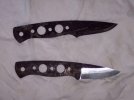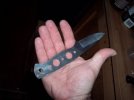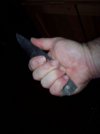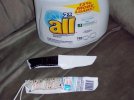1066vik
Gold Member
- Joined
- Nov 28, 2009
- Messages
- 21,350
A while back Dan put out a post looking for some knife testers.
My pair showed up yesterday. I have no idea what the steel is, or what it's going to be when they go into production.
I got ugly, as quenched blades with a decent functional edge. 1 scandi, and the other what I would consider a high flat saber grind.
Out of the box, the points are needle sharp and quick flicking cuts shredded the cardboard - all the way through. push and pull cuts in newsprint were also easy.
The handle has plenty of holes of differing sizes that would be useful as lashing points or for attaching permanent scales.
The notched cut into the spine for thumb index are a bit too close together IMHO - they're sharp enough to use as a wood or plastic file/saw. OTOH, they also worked great for shaving a magnesium bar for fire starting and the spine is squared perfectly for the flint rod - threw great sparks.
The edges all the way around are "sharp", and the butt of the blade dug into the meat at the back of my hand, so first thing to do was to cover the handles. One got about 14' of paracord wrapped around it (ugly, but it works), the other got scales made of cardboard wrapped in electrical tape. (again, ugly - but effective)
After cooking dinner, I cut up a laundry detergent jug (hobo kydex) and made quick positive retention sheathes for them - heat plastic until it's floppy, then fold over blade and mash in towel -- the heat made the plastic soft enough at the edges to melt/seal the seam. then folded a strip over the end of the tang to lock it in place. not as fast as cardboard & duct tape, but more durable.
Food prep - the flat grind worked better for slicing veggies. (onion & broccoli)
Fire starting - both made great feathersticks, shaved magnesium, and threw sparks on the flint rod. When held perpendicular to a piece of beechwood, the scandi scraped see through feather shavings, the flat merely made dust.
Wood carving: my wife preferred the flat grind for detail work, even though she considered the blade shape too "fat" for fine detail carving. I had equal luck with both drilling holes, cutting, whittling, shaving, etc... on a green walnut stick I had in the woodpile -- either would be fine for making traps, triggers, etc...
Overall, I found this to be a good design. No overall preference for either grind, as each does some things better than the other, and the only suggestions I can make for improvement would be to use coarser jimping at the spine or leave it off altogether, maybe round the butt a little more so it doesn't bite, and to make the handles about 1/8" narrower for folks with smaller hands than mine. (I love the handle size - my wife, her sister, and BiL all thought it was a little wide - but then they're fine boned and have small hands, while I'm... um, not...)
I'm happy enough with the functionality of the blade that I'm taking the scandi on a roofing job this afternoon.
My pair showed up yesterday. I have no idea what the steel is, or what it's going to be when they go into production.
I got ugly, as quenched blades with a decent functional edge. 1 scandi, and the other what I would consider a high flat saber grind.
Out of the box, the points are needle sharp and quick flicking cuts shredded the cardboard - all the way through. push and pull cuts in newsprint were also easy.
The handle has plenty of holes of differing sizes that would be useful as lashing points or for attaching permanent scales.
The notched cut into the spine for thumb index are a bit too close together IMHO - they're sharp enough to use as a wood or plastic file/saw. OTOH, they also worked great for shaving a magnesium bar for fire starting and the spine is squared perfectly for the flint rod - threw great sparks.
The edges all the way around are "sharp", and the butt of the blade dug into the meat at the back of my hand, so first thing to do was to cover the handles. One got about 14' of paracord wrapped around it (ugly, but it works), the other got scales made of cardboard wrapped in electrical tape. (again, ugly - but effective)
After cooking dinner, I cut up a laundry detergent jug (hobo kydex) and made quick positive retention sheathes for them - heat plastic until it's floppy, then fold over blade and mash in towel -- the heat made the plastic soft enough at the edges to melt/seal the seam. then folded a strip over the end of the tang to lock it in place. not as fast as cardboard & duct tape, but more durable.
Food prep - the flat grind worked better for slicing veggies. (onion & broccoli)
Fire starting - both made great feathersticks, shaved magnesium, and threw sparks on the flint rod. When held perpendicular to a piece of beechwood, the scandi scraped see through feather shavings, the flat merely made dust.
Wood carving: my wife preferred the flat grind for detail work, even though she considered the blade shape too "fat" for fine detail carving. I had equal luck with both drilling holes, cutting, whittling, shaving, etc... on a green walnut stick I had in the woodpile -- either would be fine for making traps, triggers, etc...
Overall, I found this to be a good design. No overall preference for either grind, as each does some things better than the other, and the only suggestions I can make for improvement would be to use coarser jimping at the spine or leave it off altogether, maybe round the butt a little more so it doesn't bite, and to make the handles about 1/8" narrower for folks with smaller hands than mine. (I love the handle size - my wife, her sister, and BiL all thought it was a little wide - but then they're fine boned and have small hands, while I'm... um, not...)
I'm happy enough with the functionality of the blade that I'm taking the scandi on a roofing job this afternoon.










